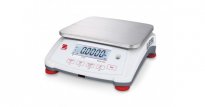Portion scale definition

If you’re on a diet, you’re watching serving sizes and calories. A great way to keep yourself honest is to use a food scale. Why? Because many people normally eat servings that are much larger than recommended amounts. A food scale teaches you portion control and keeps you from eating more than you planned.
“I definitely promote food scales, ” says Liz Weinandy, RD, MPH, a dietitian in the non-surgical weight-loss program at Ohio State University Medical Center in Columbus.
A food scale can be used for any meal plan or diet that specifies a serving size in ounces. A national survey of more than 6, 000 adults showed that people who measured their food were more successful at losing weight and keeping it off than those who did not.
Food Scale: How it Works
When starting a diet, measuring food is an important part of learning about correct serving sizes. A food scale will show you that the portion you thought was four ounces may actually weigh eight ounces. That’s the kind of mistake that could derail your diet.
Weinandy stresses that a food scale is only one of the measuring tools you will need; measuring cups and spoons are also essential diet implements. Food scales are best for meat, which should weigh in at 3 ounces per serving, and cheese, 1.5 ounces per serving. Cups are best for cooked pasta or rice — a serving is 1/2 cup — and fruits and vegetables.
Generally you’ll measure your food after it is cooked. However, a food scale may also be handy if you are preparing meals using meal plans or recipes that specify certain weights of ingredients.
Food Scale: Calculating Portion Sizes While Eating Out
You could take along your measuring cups and scales when eating out, but that is a bulky way to travel. Weinandy prefers teaching dieters about visual comparisons that can help guide their recognition of serving sizes on their plate.
For example, a serving of meat is about the size of a deck of cards, and a serving of pasta should fit in the palm of your hand.
“I really focus on those [images] because people can visualize them when they are out and about, ” Weinandy says.
If you frequently use a food scale at home, you will gradually become accustomed to the look and feel of correct serving sizes. Data show that exposure to correct serving sizes does help people make better choices in restaurant settings, too.
Food Scale: Choosing the Best One
Food scales range from a small plastic cup on a small plastic base to old-fashioned metal scales with weights and measures to expensive, programmable digital scales that can give you the full nutritional information for each serving size. The best food scale for you:
- Has numbers you can read easily
- Has a cup or bowl large enough to hold the food you need to weigh
- Is easy to clean and store
“What I find is that people will go out and buy one and then it ends up in the cupboard, ” says Weinandy. “I usually just recommend one of the cheaper kinds. It’s not like you’re measuring your food for some kind of experiment.”
If you find that measuring your food suits you, you may want to upgrade to a more expensive model. “Some people really like to get very precise with a food scale, ” she says.
Related posts:

 One of the more cost-effective measurements in a paper mill is that which monitors the flow of pulp stock into the head box of the paper machine. The stock level…
One of the more cost-effective measurements in a paper mill is that which monitors the flow of pulp stock into the head box of the paper machine. The stock level… Why is taking all the tricks called a boston in pinochle what are kegel exercises How to change administrator on windows 10? In what order should you learn tricks…
Why is taking all the tricks called a boston in pinochle what are kegel exercises How to change administrator on windows 10? In what order should you learn tricks… Overview Marel Marine Scales are specifically designed for use on board fishing vessels and factory trawlers. This cost-effective series of scales ranges from the…
Overview Marel Marine Scales are specifically designed for use on board fishing vessels and factory trawlers. This cost-effective series of scales ranges from the… How long to air fry french fries what does fafsa stand for What does it mean when ypu use alocohol and the tips of your fingers turn white Who raps bitches aint…
How long to air fry french fries what does fafsa stand for What does it mean when ypu use alocohol and the tips of your fingers turn white Who raps bitches aint… Globe s portion control scales can be used in a wide spectrum of applications from delis and pizza parlors, to bakeries and restaurants, or any establishment where…
Globe s portion control scales can be used in a wide spectrum of applications from delis and pizza parlors, to bakeries and restaurants, or any establishment where…